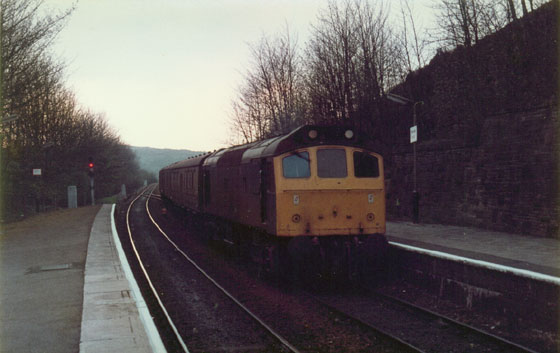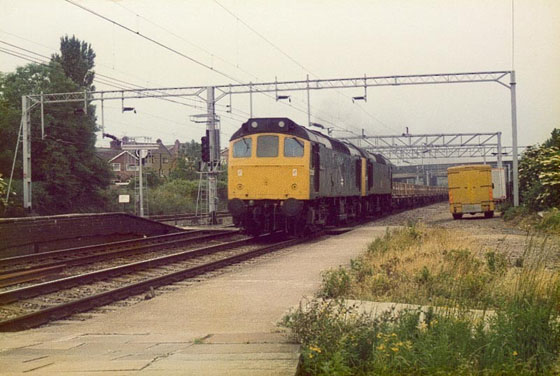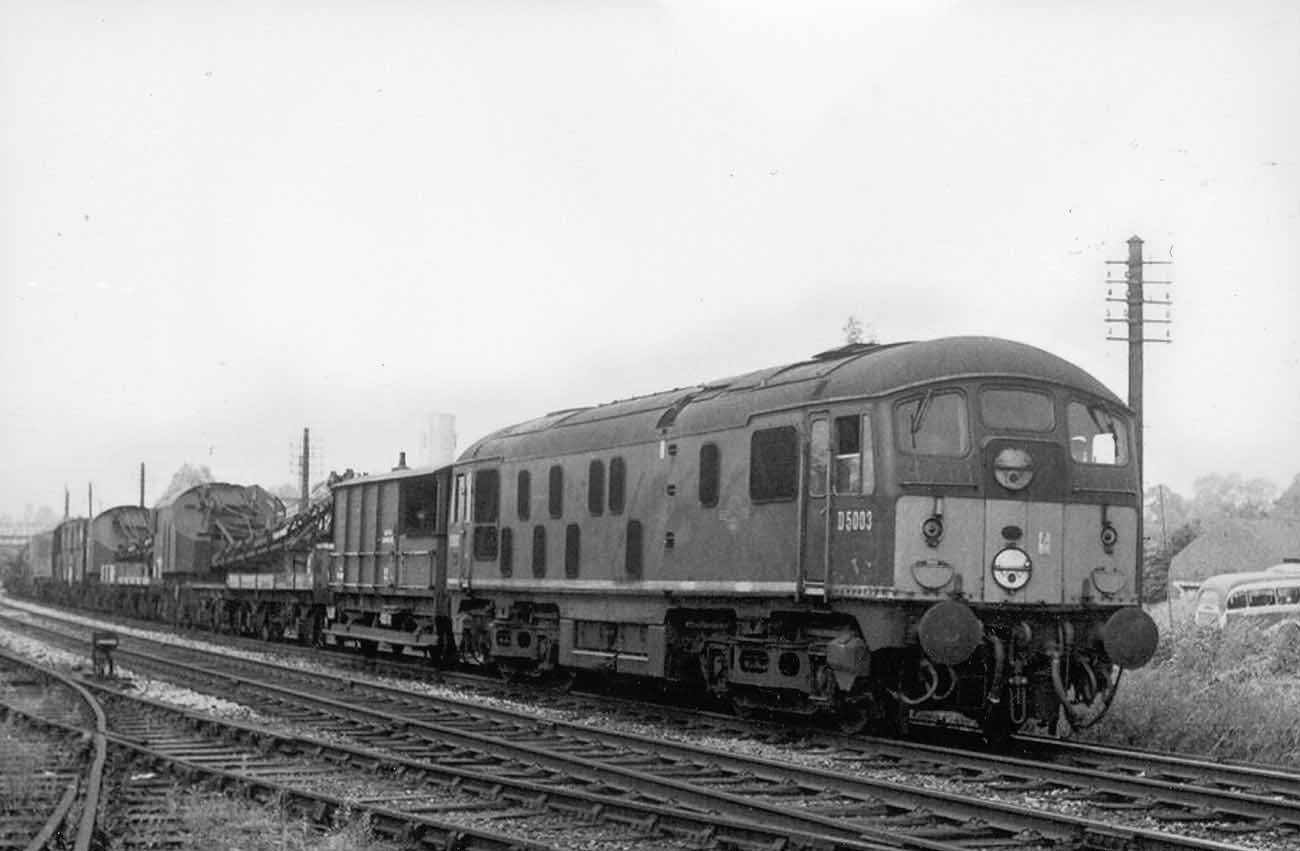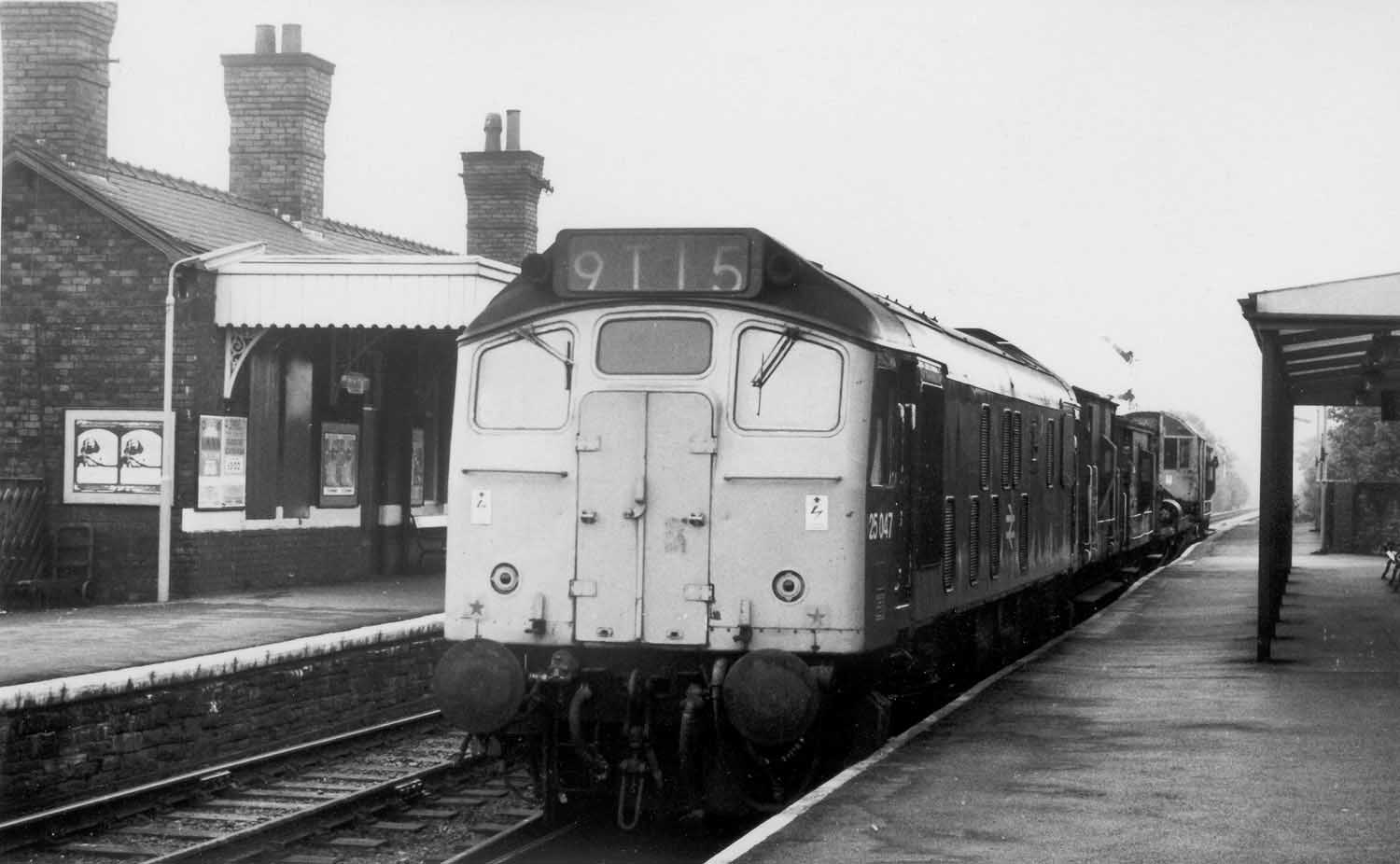This page takes a look at a few of the freight and parcels workings that were a staple of the Class 25s work on British Railways. The workings shown below hopefully describe and illustrate some of those jobs where Class 25s were regularly diagrammed so that on any given day one could expect that a Class 25 would turn up.
![]()
1P39 15.27 Euston - Heysham parcels
Observations in 1968 that this service was electrically hauled to Crewe then by diesel to Heysham. This was frequently a Class 25 turn, with the occasional Class 24.
![]()
1M25 18.08 Manchester Piccadilly - St Pancras parcels

This had been a Class 25 working for many years, substitutues when they did occur were either Class 40s or 47s. Double headed Class 25's were extremely rare on this job. This turn did not run on Sundays.
In October 1982 Class 40s were diagrammed to take over this turn. October 1st saw the surprise combination of 37128 & 40164, the next day it was 25279 then Class 40's settled in for the remainder of the week. More Class 25's returned between October 9th & 19th, after this it became a solid Class 40 turn with only occasional Class 25 substitutions. When the Class 25's had held this turn it was rare to see the same locomotive on consecutive nights, but with the arrival of the Class 40's it became common to see the same locomotive on two or three consecutive nights.
The spring of 1983 saw the dominance of the Class 40s decrease on this turn, more Class 37s and Class 47s showed up as well as the occasional Class 25.
At Derby the locomotive bringing in the train from Manchester would be replaced by a Class 45/1 for the run up to St Pancras. Quite frequently the Class 25 would quickly return north light engine to Guide Bridge or sometimes Longsight, infrequently the Class 25 would return north on freight workings, in particular the 6M98 Parkeston Quay - Warrington Arpley Speedlink.
![]()
3M07 03.37 Stranraer - Euston parcels (diverted)


![]()
Ditton - Broughton Lane, Sheffield BOC tanks

1981
July 21st 25060 & 40197
August 11th 25199 & 40118
August 20th 25321 & 40171
1982
February 15th 40028 & 25178 eastbound at Sheffield
March 18th 40033 & 25287 westbound at Sheffield
April 8th 40076 & 25285 westbound at Stockport
April 13th 40085 & 25285 westbound at Guide Bridge, 25285 leading
June 19th 40155 & 40097 eastbound at Sheffield
June 19th 40155 westbound at Sheffield
June 26th 40050 & 40186 westbound at Sheffield.
1983
February 8th 40181 & 25286
February 15th 40091 & 25320 eastbound at Sheffield
March 1st 25193 & 40185 eastbound at Chinley.
May 10th 40050 & 40077 eastbound
May 10th 40050 westbound Skelton Junction
May 31st 40069 & 40197 throughout
June 2nd 40196 westbound at Sheffield
June 7th 40080 & 40085 throughout
July 7th 25323 & 40035 throughout
July 9th 40152 & 40022 westbound at Sheffield
July 16th 40131 & 25313 westbound at Broughton Lane
July 28th 25307 & 25106 westbound at Skelton Junction.
August 6th 40022 & 25230 westbound at Broughton Lane
August 9th 40035 westbound at Sheffield
September 17th 40104 & 25307 eastbound at Sheffield
September 27th 40033 & 25212 throughout.
October 8th 25278 & 25259 westbound at Dore
October 11th 25259 & 40118 throughout.
1984
January 26th 25282 & 40058
April 14th 25307 & 40002 (25307 leading westbound)
April 28th 40196 & 25254
April 29th 25249 & 25262 (an extra working)
May 5th 40155 & 25059
May 15th 40001 & 25209
May 29th 40056 & 25229 (see photograph above)
May 31st 40079 & 25276
June 5th 40150 & 25325
June 16th 40195 & 25182 westbound at Chinley
August 4th 25178 & 40181
August 9th 25176 & 40155 westbound at Dore, 25176 leading
August 13th 25213 & 40192
August 17th 25181 & 40044
August 22nd 25201 & 40028 **
October 3rd 40099 & 25239
October 8th 25199 & 40194
December 5th 47156 eastbound at Ashburys, extra working
**By this time incursions by Class 47s were becoming more frequent, by October they would be the norm.
Undated
25205 & 40050 westbound at Sheffield Midland.
The rapidly increasing withdrawals of both Classes 25 & 40 saw this working trialled with Classes 37, 47 & 56 during late September/early October. However October 3rd found the working behind 40099 & 25239, and on October 8th saw 25199 & 40194. By month end Class 47’s would be in charge of the BOC working.
The plant at Ditton also sent out tanks to a variety of other locations, these were not normally hauled by Class 25/40 combinations. However from time to time this combination did work to other destinations.
January 22nd 1982 the 11.30 Ditton – Corby BOC special was hauled by 25250 & 40127.
The Ditton – Wolverhampton BOC working was diagrammed for pairs of Class 25’s but occasionally featured a Class 25/40 mix. On August 4th 1983 a special Ditton – Polmadie working used 25202 & 40131.

Brick Workings
Brick making commenced at Wootton Pillinge, Bedfordshire during 1897. The location was renamed Stewartby in 1937 to reflect the importance of the Stewart family who had been directors of the London Brick Company since 1900. Between 1926 & 1937 the company was known as the London Brick Company & Forders Ltd. At one time 167 chimneys were present on the site, during the 1970s 20% of the United Kingdom's bricks were produced here.
By 1968 company trains of bogie brick wagons ran to Guide Bridge (4H24), St Helens (4F48), Bordersley (4H08) and Willesden (4A32).
In May 1973 Forders installed a new brick loading facility using two overhead cranes, with freightliner wagons carrying loaded pallets of bricks. A typical train for a pair of Cricklewood based dual-braked Class 25s, supplied by Bletchley or Bedford, was fiften 'fletliners', with destinations of Garston, Trafford Park and Kings Cross Goods. In the event of only a single Class 25 being available the load was reduced with only eight wagons being loaded. The 1,000th brick train ran in June 1976.
The wagons were composed of FFA inners and FGA outers. With a typical fifteen wagon train a total of 315,000 bricks could be carried.
In 1984 London Brick was taken over by Hanson and a switch to road transport saw the last Kings Cross flow run in October 1984 complete with a wreath on the lead loco, 25288.
During 2005/2006 attempts were made to minimise the sulphur dioxide emissions, presumably without success as the facility closed in 2008. Four of the 230 foot high chimneys survived the closure.
For the purposes of this segment, the brick trains to Kings Cross/St Pancras & Garston are covered separately.
Forder's Sidings - Kings Cross / St Pancras
The notes and views below are courtesy of Nick Ross and form the beginning of a look at the Brick trains that were once workings regularly handled by the Class 25s.
Several workings identified by Nick so far are:
4E78 1930 SX Forder’s- Kings Cross Goods
4M80 1025 SX Kings Cross Goods – Forder's
6A31 1735 Forder's – St Pancras Churchyard Sdgns
These workings could be heavy, maybe 900 tons plus of bricks bound for Kings Cross or Garston.
The 4E78 was made up of FFA liners with FGA outers basically modified Freightliner flats running in 48 SLU’s formation. London Brick panels on the brick pallets added to the trains character.
In 1984 after London Brick was acquired by Hanson a switch to road transport was made. The last Kings Cross flow ran in October 1984 (also reported as February 1985) complete with a wreath on the lead loco, 25288.



Stewartby - Garston brick train
4F53 Forders - Garston FLT with portions for London Brick Company yards in the Liverpool and Manchester areas. The wagons ran in sets of five with three sets per train generally.
The 4F53 departed Forders about 14.00 ran via Bedford, Wigston South Junction, Nuneaton, Crewe, Manchester area and Garston. In the Manchester area the train was split at either Trafford Park FLT or Longsight FLT.
Bedford men worked it as far as Wigston, handing over to Leicester men. Always a pair of 25's and usually the higher numbered examples, apparently they stood more chance of lasting the trip!
The empties returned south via the WCML to Bletchley to avoid a runround at Forders.
The Forders - Garston service ended on January 25th 1985 with 25249 working the last loaded train.



![]()
Heysham - Neville Hill oil tanks
19/07/67 5177 & 92227 at Hest Bank 7N54 (en-route to handle an oil train?)
27/07/67 5177 & 48067 eastbound at Long Preston (4N28).
30/09/67 5254 & 92128 eastbound at Leeds 7N28
02/04/68 5174 & 92167 eastbound Carnforth 7N2?
08/04/68 5170 & 92077 eastbound Settle Junction 7N28
26/04/68 5171 & 9F eastbound at Carnforth 4N28 (or 7N28?)
08/06/68 5168 & 92167 eastbound at Carnforth 5N28
10/07/68 5182 & 92088 at Hest Bank
19/07/68 7624 & 45206 eastbound 5N28
00/00/00 5179 & 92167 eastbound Skipton
00/00/00 7625 & 8F eastbound Long Preston (5N28)

![]()
Miscellaneous Engineers Workings
Here are a number of views of Class 24/25s on a type of working that they were very well suited for - the engineering/permanent way trains that were a staple of weekend engineering works.



![]()
More workings to be added as time permits.
Page added December 23rd 2007.
Last updated May 20th 2024.